| Author |
Message |
Thomas McDonald
myArmoury Alumni


|
 Posted: Mon 13 Nov, 2006 8:25 am Post subject: Posted: Mon 13 Nov, 2006 8:25 am Post subject: |
 |
|
JFWIW ....
Here be some detail shots of the 'MacKay' targaid, at the Hunterian Museum, Glasgow !
This is one is listed as the earliest dated targe which has '1623' engraved on its brass boss.
 Attachment: 77.49 KB Attachment: 77.49 KB
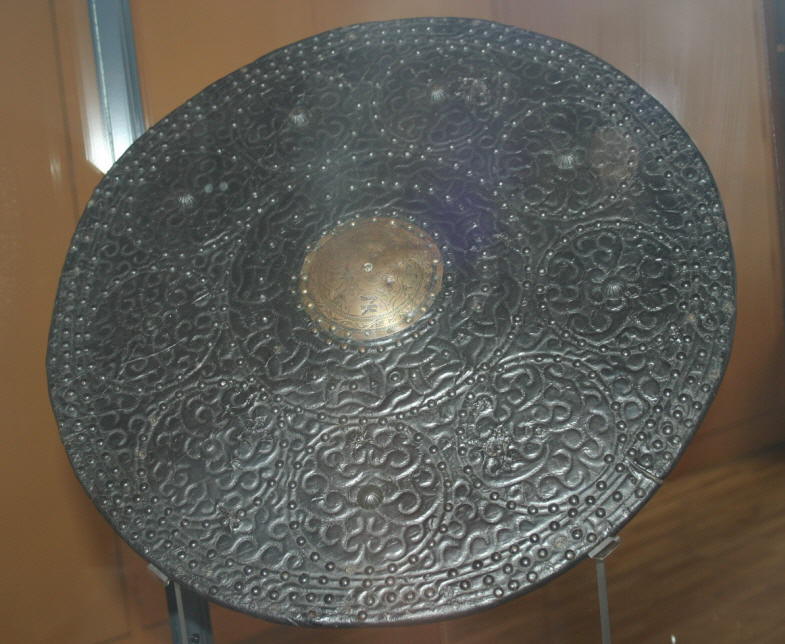
 Attachment: 86.88 KB Attachment: 86.88 KB
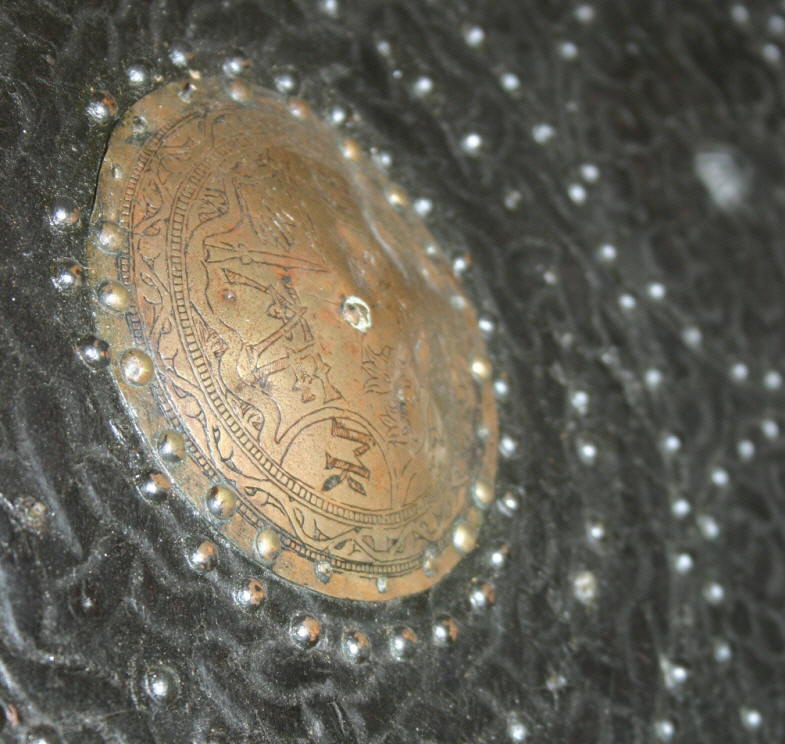
 Attachment: 51.76 KB Attachment: 51.76 KB
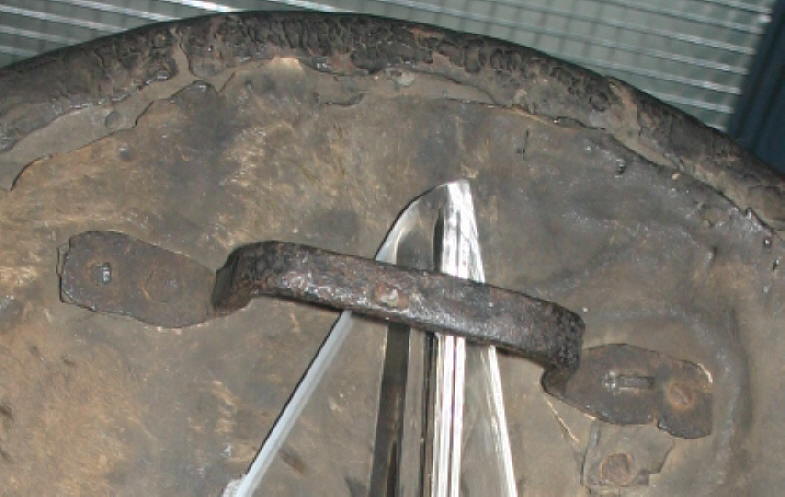
 Attachment: 84.91 KB Attachment: 84.91 KB
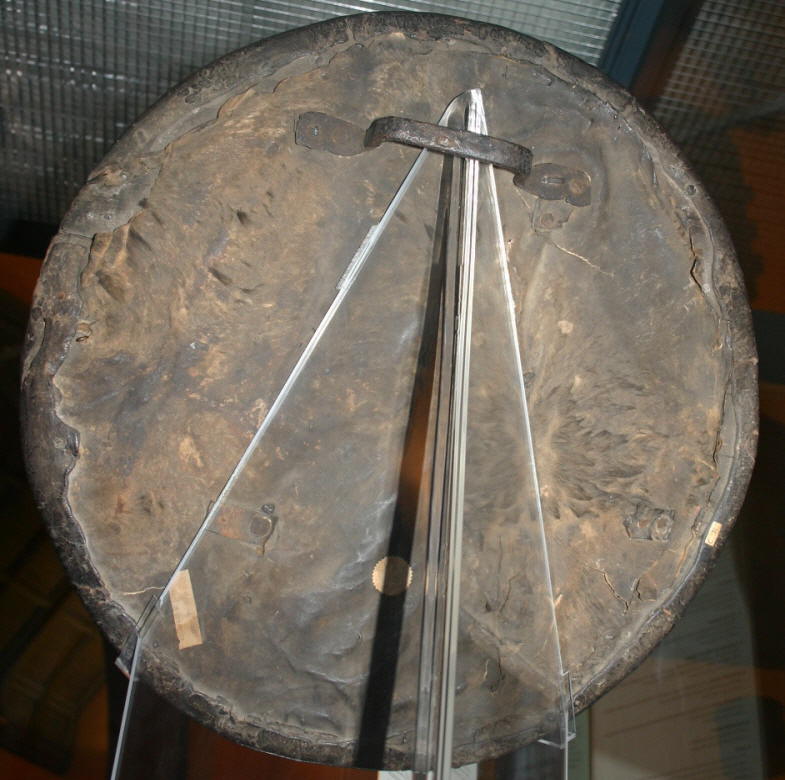
 Attachment: 58.97 KB Attachment: 58.97 KB
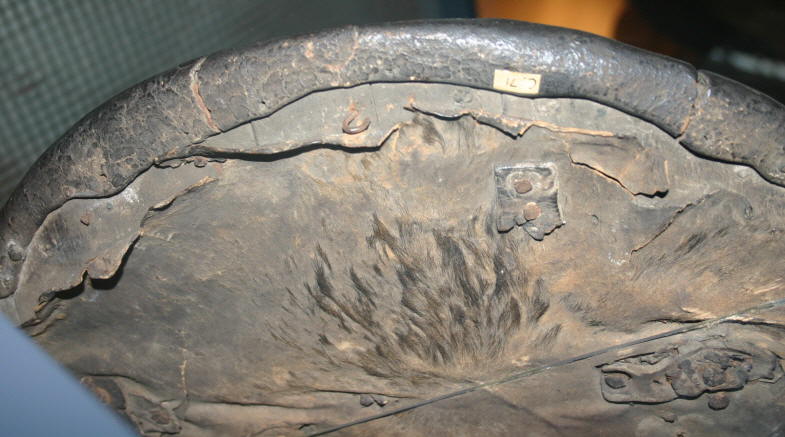
 Attachment: 47.25 KB Attachment: 47.25 KB
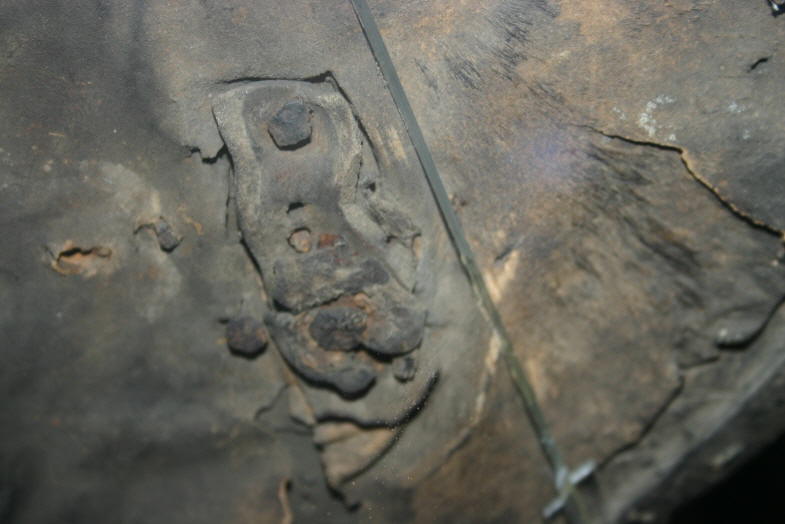
'Gott Bewahr Die Oprechte Schotten'
XX ANDRIA XX FARARA XX
Mac's PictureTrail
|
|
   |
 |
|
Martin Wilkinson
|
 Posted: Mon 13 Nov, 2006 9:51 am Post subject: Posted: Mon 13 Nov, 2006 9:51 am Post subject: |
 |
|
interesting handle on that thing...
Another example that helps me prove that Targes existed during the civil war.
"A bullet you see may go anywhere, but steel's, almost bound to go somewhere."
Schola Gladiatoria
|
|
   |
 |
Henrik Bjoern Boegh

Location: Agder, Norway Joined: 03 Mar 2004
Posts: 386
|
 Posted: Mon 13 Nov, 2006 10:23 am Post subject: Posted: Mon 13 Nov, 2006 10:23 am Post subject: |
 |
|
Martin, I'm led to believe that also the Reivers did use targes from time to time...
Mac,
Thanks for the pics. That targe is lovely!
Cheers,
Henrik
Constant and true.
|
|
  |
 |
|
Martin Wilkinson
|
 Posted: Mon 13 Nov, 2006 4:30 pm Post subject: Posted: Mon 13 Nov, 2006 4:30 pm Post subject: |
 |
|
| Henrik Bjoern Boegh wrote: | Martin, I'm led to believe that also the Reivers did use targes from time to time...
Mac,
Thanks for the pics. That targe is lovely!
Cheers,
Henrik |
Yeah, i had that impression too, thanks to an Osprey, so i'm not going to 100% believe it, until i see some concrete evidence...
"A bullet you see may go anywhere, but steel's, almost bound to go somewhere."
Schola Gladiatoria
|
|
   |
 |
Merv Cannon

|
 Posted: Mon 13 Nov, 2006 6:21 pm Post subject: Targes Posted: Mon 13 Nov, 2006 6:21 pm Post subject: Targes |
 |
|
| GG Osborne wrote: | | Merv, if you can get a copy of Drummond's Ancient Scottish Weapons, there is a large section which shows some very early circular shields straight through to the classic targe of 1745. One or two illustrations clearly show burial recoveries that indicate Norse or Northern European influence. Take a look. The book is available from Unicorn Press on a CD. |
Hey, thanks heaps G.G..........I got my CD-copy today and Im over the moon...............fantastic ! Not to mention you get all this other neat stuff as well........even bagpipe carvings ! great !! Also theres a wierd sword that Im gonna just have to ask about in a post....the one with a 4-bar cross-hilt ! 
Thanks again !
Cheers !
Merv ....... KOLR
http://www.lionrampant.com.au/
"Then let slip the dogs of war ! "......Woof !
|
|
   |
 |
|
GG Osborne
|
 Posted: Mon 13 Nov, 2006 7:50 pm Post subject: Posted: Mon 13 Nov, 2006 7:50 pm Post subject: |
 |
|
Joe Lindsey, the Tragemaker of Inverness, has a nice repro of the MacKay targaid on his site - www.targemaker.co.uk- sans engraving on the central boss. It's a nice looking targe.
"Those who live by the sword...will usually die with a huge, unpaid credit card balance!"
|
|
  |
 |
Merv Cannon

|
|
   |
 |
|
Lin Robinson
|
 Posted: Tue 14 Nov, 2006 4:50 am Post subject: Re: Targaid Posted: Tue 14 Nov, 2006 4:50 am Post subject: Re: Targaid |
 |
|
That is an interesting piece. I agree that it is probably not an original. For one thing the leather just looks too fresh. But it is well-done, if it is a copy.
Lin Robinson
"The best thing in life is to crush your enemies, see them driven before you and hear the lamentation of their women." Conan the Barbarian, 1982
|
|
  |
 |
Thomas McDonald
myArmoury Alumni


|
 Posted: Tue 14 Nov, 2006 6:08 am Post subject: Posted: Tue 14 Nov, 2006 6:08 am Post subject: |
 |
|
Targe researcher Larry Davis brought that one to our attention in this SFI Scottish Forum thread:
Targe at Auction
He pointed out its design elements are very similar to one James Drummond drew in "Ancient Scottish Weapons", 1881.
My guess is that it's not a period original, but a very good older reproduction.
Mac
 Attachment: 63.74 KB Attachment: 63.74 KB
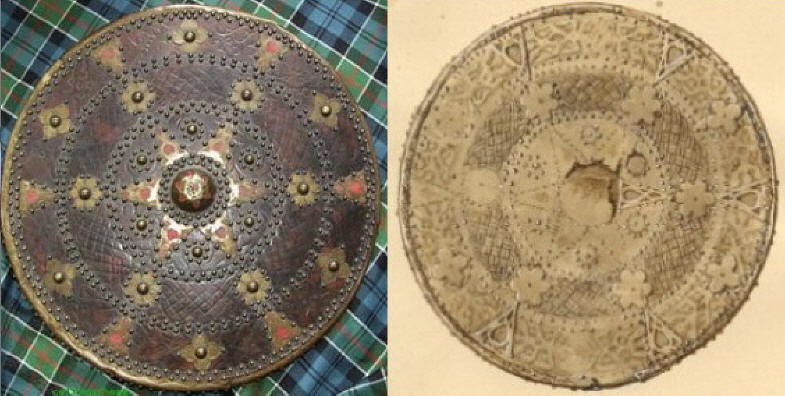
'Gott Bewahr Die Oprechte Schotten'
XX ANDRIA XX FARARA XX
Mac's PictureTrail
|
|
   |
 |
|
GG Osborne
|
 Posted: Tue 14 Nov, 2006 7:47 am Post subject: Posted: Tue 14 Nov, 2006 7:47 am Post subject: |
 |
|
For those that might be interested: Out of curosity, I contacted my friend Joe Lindsey of Inverness ("the Targemaker") and asked if he had any interest in making a reproduction of the Gywnn targaid. He replied that he had often considered it but had not had the opportunity. Well, I suppose this served as opportunity and he has agreed to make one, only without the boss engravings. I think what had his attention was that the central boss of the original is engraved "Inverness." It should be ready in early 2007.
Oh yes, Mac, he asked if you had any idea of what the grip structure on the targe looked like?
"Those who live by the sword...will usually die with a huge, unpaid credit card balance!"
|
|
  |
 |
Henrik Bjoern Boegh

Location: Agder, Norway Joined: 03 Mar 2004
Posts: 386
|
 Posted: Tue 14 Nov, 2006 8:30 am Post subject: Posted: Tue 14 Nov, 2006 8:30 am Post subject: |
 |
|
Wow! That's great news, George! I hope you learn how to use your camera by then :-D hehe
I visited the Targemakers workshop some years ago and got to handle a couple of his targes. Those are neat! I wish I'll afford one soon. Ah, well...
Cheers,
Henrik
Constant and true.
|
|
  |
 |
Thomas McDonald
myArmoury Alumni


|
 Posted: Tue 14 Nov, 2006 8:50 am Post subject: Posted: Tue 14 Nov, 2006 8:50 am Post subject: |
 |
|
Hi George
I've never seen the backside of the Gwynn targaid.
I did read the following quote in Dr. Caldwell's book (Scottish Weapons & Fortifications 1100-1800) which has an article on this piece, describing the backside as:
"covered with deer(?)skin, fur side outwards, and shows traces of the attachments for the brases by which it was secured to the arm"
* did postup a few pages of this article in this old thread http://www.myArmoury.com/talk/viewtopic.php?t=5307&start=20
Mac
'Gott Bewahr Die Oprechte Schotten'
XX ANDRIA XX FARARA XX
Mac's PictureTrail
|
|
   |
 |
Thomas McDonald
myArmoury Alumni


|
 Posted: Tue 14 Nov, 2006 9:40 am Post subject: Posted: Tue 14 Nov, 2006 9:40 am Post subject: |
 |
|
| Lin Robinson wrote: | There is a description of a "bullet proof" targe that was set down by Alexander Fletcher of Saltoun in 1716. It is too lengthy to post here, Briefly, the targe supposedly had a thin steel plate on the inside, which was covered with a deer skin with the hair on. Next came a layer of wool which was "stuffed in very hard" to quote Fletcher. On top of the wool was what Fletcher described as cork, but later calls an "excrescence of their Birk trees". What he was actually talking about I do not have a clue, but it was wood of some sort. Finally came the leather cover, decorative tacks, plates, etc. that are commonly seen on targes. He does say that the steel plate was not very heavy. Too much weight and the targe becomes useless. He also mentions the spike and says it "wounds the Enemy when they are close". Fletcher was a Lowlander and may not have understood the use of the targe in combat.
In 1988 I met a gentleman who had built a targe using the description written by Fletcher. He had fired two musket balls at the targe at a range of 50 yards. Neither penetrated completely but one did push almost through the inside layer. However, when I picked the thing up, it was so heavy that I think it would have been nearly impossible to use it as a shiedl in action.
I cannot speak to the plains Indians' ability to bullet proof a shield except to say that regularly used variious forms of "magic' to become bullet proof and it never worked as far as I know. The great Cheyene chief, Roman Nose, was supposed to be impervious to bullets as long as he did not eat food lifted from the fire with an iron utensil. Unfortunately, just before the battle of Beecher's Island, he ate some fry bread that had been touched by iron and was killed in the battle. That has absolutely nothing to do with bullet proofing a shield, it just came to mind. |
Postscript to an article on the Gwynn targaid, in "Scottish Weapons & Fortifications 1100-1800", by David Caldwell.
Mac
 Attachment: 91.95 KB Attachment: 91.95 KB
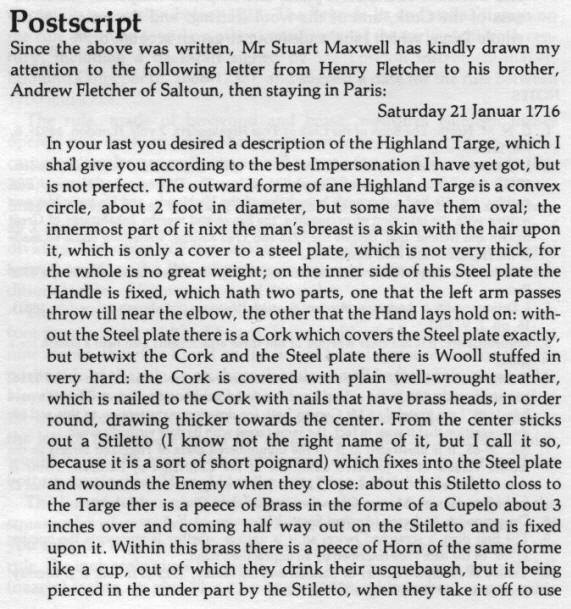
 Attachment: 64.89 KB Attachment: 64.89 KB
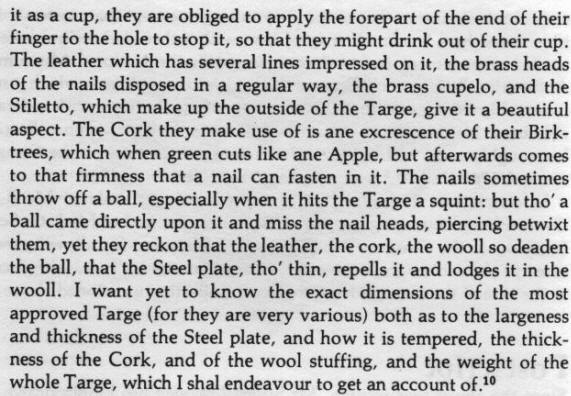
'Gott Bewahr Die Oprechte Schotten'
XX ANDRIA XX FARARA XX
Mac's PictureTrail
|
|
   |
 |
Merv Cannon

|
 Posted: Wed 15 Nov, 2006 5:11 am Post subject: Targaid Posted: Wed 15 Nov, 2006 5:11 am Post subject: Targaid |
 |
|
Firstly, I am imensely grateful for the data thats been posted here and the pics.
I have noticed the most Targes seem to be at least a little curved.......is that a general rule....are they all slightly curved or are some completely flat ? Also...those decrative brass nails...are they solid, or hollow like modern upholstery Tacks ?
You see......being "Down Under" really means way down under ! You dont just wander into a museum here and see original Targes and Swords, although there would be some in collections somewhere....thats why I really appreciate the detailed info ! Dont get me wrong, reenactment and History is huge here....we pulled in over 14,500 people in one weekend at our local annual Medieval reenactment event and my city has more that 23 medieval reenactment groups ( yes, it also has the SCA ) and other groups like WW I & II and Boer War, Georgian Navy, etc.
I have taken opportunity to sneek in a Sword Pic...if it warrants a seperate Post-Topic then I'll open one......otherwise it may not be worth it.......its the Claymore with a four-piece hilt ! Basically, my question is...." What the...? "
Also someone's repro Targaid with a Dirk where the Spike would be normally be kept....I thought it silly at first, and then I thought that if I was in combat, it might be an ok idea in an emergency.......But is there any reference historically for this ?
 Attachment: 28 KB Attachment: 28 KB
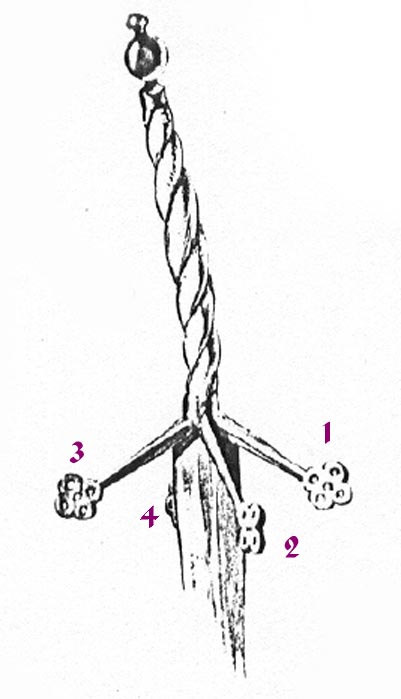
 Attachment: 110.48 KB Attachment: 110.48 KB
[ Download ]
Merv ....... KOLR
http://www.lionrampant.com.au/
"Then let slip the dogs of war ! "......Woof !
|
|
   |
 |
|
Martin Wilkinson
|
 Posted: Wed 15 Nov, 2006 7:01 am Post subject: Posted: Wed 15 Nov, 2006 7:01 am Post subject: |
 |
|
Claymore does not refer to the two handed swords, it means basket-hilted broadsword.
The classic scottish two handers are called either "twa handed swerd" or CDL (i can't remember the full gaelic name, i refer to them as CDL's...).
But, that targe is an interesting idea, not sure how practical it is though.
"A bullet you see may go anywhere, but steel's, almost bound to go somewhere."
Schola Gladiatoria
|
|
   |
 |
Chad Arnow
myArmoury Team


|
 Posted: Wed 15 Nov, 2006 10:07 am Post subject: Posted: Wed 15 Nov, 2006 10:07 am Post subject: |
 |
|
| Martin Wilkinson wrote: | Claymore does not refer to the two handed swords, it means basket-hilted broadsword.
|
Not so. Claymore is a bastardized spelling of the Gaelic words for "Great Sword." The application of that term to basket hilts is the misnomer (even though it's an old and entrenched misnomer).

ChadA
http://chadarnow.com/
|
|
    |
 |
|
Martin Wilkinson
|
 Posted: Wed 15 Nov, 2006 10:21 am Post subject: Posted: Wed 15 Nov, 2006 10:21 am Post subject: |
 |
|
| Chad Arnow wrote: | | Martin Wilkinson wrote: | Claymore does not refer to the two handed swords, it means basket-hilted broadsword.
|
Not so. Claymore is a bastardized spelling of the Gaelic words for "Great Sword." The application of that term to basket hilts is the misnomer (even though it's an old and entrenched misnomer). |
Chad, go read SPADA 2.
"A bullet you see may go anywhere, but steel's, almost bound to go somewhere."
Schola Gladiatoria
|
|
   |
 |
Chad Arnow
myArmoury Team


|
 Posted: Wed 15 Nov, 2006 11:21 am Post subject: Posted: Wed 15 Nov, 2006 11:21 am Post subject: |
 |
|
| Martin Wilkinson wrote: | | Chad, go read SPADA 2. |
Martin,
Thanks for your "advice." Perhaps you would want to post some text from that book for those of us who don't have it. That would be a helpful post.
A lot of people will agree with me on these terms. There is a term some people use for 2-handers, something like "claidheamh da lamh" which roughly translates to "2-handed sword." Some people prefer to use it and keep claymore reserved for basket-hilts.
However, what is not in dispute is that "claymore" comes from the Gaelic for "great" or "large" sword. Claidheamh mòr = big sword.
It's like defining bastard and longsword. There are modern definitions that some swear to, but they may have nothng to do with the word's original useage or origins.
I use "claymore" for the 2 hander and "Scottish basket-hilt" for, well, Scottish basket-hilts.

ChadA
http://chadarnow.com/
|
|
    |
 |
Richard Fay

|
 Posted: Wed 15 Nov, 2006 11:21 am Post subject: Posted: Wed 15 Nov, 2006 11:21 am Post subject: |
 |
|
Hello all!
Many older works state very clearly that "claymore" is indeed a bastardization of the Gaelic for great sword. Here is what Claude Blair said in European and American Arms:
| Claude Blair wrote: |
The characteristic Highland Scottish two-hand sword, the true claymore* (Gaelic claidheamh mor = great sword), used in the sixteenth and early seventeenth centuries. This had long, straight quillons that sloped up at an angle and which usually terminated in pierced quatrefoils...
The seventeenth-century version of the true claymore had an arched cross with, in the centre, a large solid shell to protect the hands.
*It is worth remarking that the term claymore was being used in England to denote the characteristic Scottish basket hilted broad sword as early as the eighteenth century. |
And here's the definition of claymore from George Cameron Stone's A Glossary of the Construction, Decoration, and Use of Arms and Armour in All Countries and in All Times:
| George Cameron Stone wrote: |
Claymore-Originally the Scotch two-handed sword of the 15th and 16th centuries. The claidheamh-mor or claidmhichean-mhora. It had a long, heavy blade with a straigtht grip with a small pommel and straight quillons slanting towards the blade. Usually the ends of the quillons have pierced ornaments of three or four circles.
The name is usually used for the later Scotch broadsword... |
This is from The Complete Encyclopedia of Arms & Weapons, edited by Leonid Tarrasuk and Claude Blair:
| Tarrasuk and Blair wrote: |
Claymore-a name derived from the Gaelic claidheamoh-mor, meaning "great sword". It was first used to describe the large cross-hilted broadsword used in the Scottish highlands and by Scottish mercenaries in Ireland from the late 15th to the early 17th century...
Several Scottish literary references indicate that the term "claymore" was applied by Gaelic speakers in the Highlands to both the old-fashioned two-handed sword and the characteristic Scottish basket-hilted sword of the early 18th century. |
And again, from Gerald Weland's A Collector's Guide to Swords, Daggers, & Cutlasses:
| Gerald Weland wrote: |
...the claymore was the two-handed sword of anceint Scotland, and its name derives from the Gaelic claidheamh mor, which means great sword. Although it became widespread in the 15th and 16th centuries, its forerunners existed several centuries before then...
Claymores are frequently confused with a type of Venetian weapon known as the schiavona, a name originating from the word schiavoni (hired soldier). From the 17th century, Scottish weapons tended to be based on the Italian sword, although there is, in reality, little resemblance between the two and the newer versions were never as efficient in their purpose as the original claymore. |
And another, this time from the glossary of terms in European Edged Weapons by Terence Wise:
| Terence Wise wrote: |
Claymore-Scottish two-handed sword of the 15th to 16th centuries, now generally accepted to include the Scottish basket-hilted broadsword. |
And still another, this time from Paul Martin's Arms and Armour from the 9th to the 17th Century:
| Paul Martin wrote: |
...let us mention the long two-handed sword, with its simple quillons, used by the Scot men-at-arms: the claymore, which was still in use in the 16th century. This must not be confused with the broadsword, that double edged weapon of the 17th and 18th centuries, whose guard is formed by a basket of open ironwork, enclosing the entire grip. |
And one more, this time from Edged Weapons by Frederick Wilkinson:
| Frederick Wilkinson wrote: |
Another great sword which was in use during the 16th and early 17th Century was the claymore, the Gaelic great sword- claidheamh-mor - popular in the Scottish Highlands...
The term claymore strictly applies only to these swords; but the name had been given to another type of weapon which, more correctly, should be known as the basket-hilted broadsword. However, this type has been known as the claymore since the 18th Century and the term is now firmly established in general usage. |
So, the name is more properly applied to the two-handed sword, but could also be applied to the basket-hilted sword. Apparently, it did derive from the Gaelic for "great sword", meaning the two-handed sword.
I hoped this helped to clarify the issue!
Stay safe!
"I'm going to do what the warriors of old did! I'm going to recite poetry!"
Prince Andrew of Armar
Last edited by Richard Fay on Wed 15 Nov, 2006 12:38 pm; edited 1 time in total
|
|
 |
 |
Thomas McDonald
myArmoury Alumni


|
 Posted: Wed 15 Nov, 2006 12:37 pm Post subject: Posted: Wed 15 Nov, 2006 12:37 pm Post subject: |
 |
|
Folks, please give this one a read ....
The Word Claymore by Claude Blair
*As printed in Dr. David Caldwell's "Scottish Weapons & Fortifications 1100-1800".
Mac
'Gott Bewahr Die Oprechte Schotten'
XX ANDRIA XX FARARA XX
Mac's PictureTrail
|
|
   |
 |
|
|
You cannot post new topics in this forum
You cannot reply to topics in this forum
You cannot edit your posts in this forum
You cannot delete your posts in this forum
You cannot vote in polls in this forum
You cannot attach files in this forum
You can download files in this forum
|
All contents © Copyright 2003-2024 myArmoury.com — All rights reserved
Discussion forums powered by phpBB © The phpBB Group
Switch to the Basic Low-bandwidth Version of the forum
|

